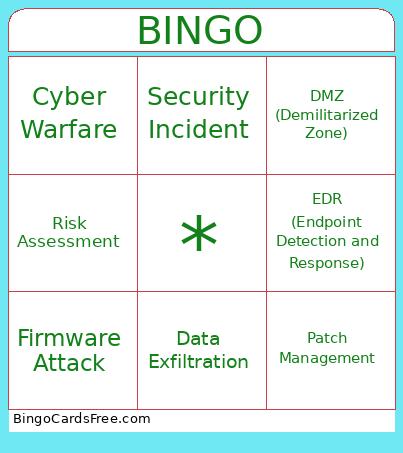bingo Cards - Print Free or Customize
Print free bingo cards or adjust them, unlimited cards! Pick from 21,800+ designs or use the bingo card generator. Add numbers, phrases, photos, or all of them. Play using PDF prints, virtual bingo cards, and the virtual bingo caller, or combine all formats.
About: This bingo card is perfect for cybersecurity training sessions, IT team meetings, or security awareness workshops. It covers a wide range of digital threats, protection strategies, and essential terms that define today’s cyber landscape. The tone is serious but approachable, making it ideal for both seasoned professionals and those looking to boost their cyber knowledge in an engaging way.
How To: To save a PDF to print, click the Print button. You can change the card count and other printing preferences on the Print tab. Grid items and free space text can be added on the Basic tab. Appearance can be highly personalized on the corresponding tabs, or you can easily find any preference on the 🔍 tab.
How to play bingo Cards?
- Printed Players: Print PDF bingo cards and physically mark the cards.
- Virtual Caller: Click on the Play button above.
- Virtual Players: Click on the Play button above, and then click on the 🎫 button.
- Printed Caller: Print PDF calling list & calling slips and physically select the slips.
- Mixed Play: Choose any combination above. For example, caller can be either Offline or Virtual. And players can be Offline or Virtual or a mix of both.
Step-By-Step:
- Start by downloading the bingo PDF by clicking on the "Print" button above.
- Open the PDF and print it.
- For random calling, you can print another copy of the call list, cut, fold and then pull them randomly at play time.
- Cut the bingo cards at the cut lines if there are more than 1 bingo cards per page.
- Give one card to each player. For marking, you can use pencils. Crayons cost the least.
- Choose one person to be the caller. If you are playing in a small group, the caller can as well play along with their own Bingo card.
- The caller opens the game by randomly drawing an item from the call list and announcing it to everyone.
- The players look at their cards to see if they have the announced word. If they do, they dab that word.
- The first player to complete a horizontal, vertical, or a diagonal line of marked items announces "Bingo!" and wins the game.
- The caller verifies that the items marked form a proper line as per the Bingo card and call list.
- You can play for different patterns or a full card blackout for an extended game.
 This bingo Cards Game contains following Words or Phrases: Phishing, Malware, Ransomware, Encryption, Firewall, Trojan, Virus, Worm, Spyware, Adware, Zero-Day, DDoS (Distributed Denial of Service), Brute Force Attack, Social Engineering, SQL Injection, XSS (Cross-site Scripting), Man-in-the-Middle, Two-Factor Authentication (2FA), Keylogger, Patch Management, Penetration Testing, Vulnerability, Cyber Hygiene, Insider Threat, Honeypot, Botnet, VPN (Virtual Private Network), Cryptography, Data Breach, Endpoint Protection, Cyber Threat Intelligence, Whitelisting, Blacklisting, Hashing, Privilege Escalation, Deep Packet Inspection, SSL/TLS, Backup, Anti-Virus, Security Incident, IDS (Intrusion Detection System), IPS (Intrusion Prevention System), Red Team, Blue Team, Rootkit, Digital Forensics, Access Control, SIEM (Security Information and Event Management), Zero Trust, Rogue Access Point, Shadow IT, Credential Stuffing, Watering Hole Attack, Drive-By Download, BYOD (Bring Your Own Device), Cyber Risk, Malware Analysis, Multi-factor Authentication (MFA), Incident Response, Data Exfiltration, Threat Modeling, Dark Web, Security Awareness, Sandboxing, APT (Advanced Persistent Threat), Threat Hunting, Password Cracking, Identity Theft, Exploit, Security Token, Integrity, Confidentiality, Availability, Bug Bounty, Session Hijacking, Packet Sniffing, DMZ (Demilitarized Zone), EDR (Endpoint Detection and Response), Risk Assessment, Certificate Authority, Spear Phishing, Threat Actor, Cyber Warfare, Security Misconfiguration, Least Privilege, Fileless Malware, Redirection Attack, Data Integrity, Insider Attack, Secure Socket Layer (SSL), Heuristic Analysis, Application Security, Secure Code, Firmware Attack, Cross-Site Request Forgery (CSRF), Attack Vector, Proxy, Cloud Security, Compliance, Security Posture.
This bingo Cards Game contains following Words or Phrases: Phishing, Malware, Ransomware, Encryption, Firewall, Trojan, Virus, Worm, Spyware, Adware, Zero-Day, DDoS (Distributed Denial of Service), Brute Force Attack, Social Engineering, SQL Injection, XSS (Cross-site Scripting), Man-in-the-Middle, Two-Factor Authentication (2FA), Keylogger, Patch Management, Penetration Testing, Vulnerability, Cyber Hygiene, Insider Threat, Honeypot, Botnet, VPN (Virtual Private Network), Cryptography, Data Breach, Endpoint Protection, Cyber Threat Intelligence, Whitelisting, Blacklisting, Hashing, Privilege Escalation, Deep Packet Inspection, SSL/TLS, Backup, Anti-Virus, Security Incident, IDS (Intrusion Detection System), IPS (Intrusion Prevention System), Red Team, Blue Team, Rootkit, Digital Forensics, Access Control, SIEM (Security Information and Event Management), Zero Trust, Rogue Access Point, Shadow IT, Credential Stuffing, Watering Hole Attack, Drive-By Download, BYOD (Bring Your Own Device), Cyber Risk, Malware Analysis, Multi-factor Authentication (MFA), Incident Response, Data Exfiltration, Threat Modeling, Dark Web, Security Awareness, Sandboxing, APT (Advanced Persistent Threat), Threat Hunting, Password Cracking, Identity Theft, Exploit, Security Token, Integrity, Confidentiality, Availability, Bug Bounty, Session Hijacking, Packet Sniffing, DMZ (Demilitarized Zone), EDR (Endpoint Detection and Response), Risk Assessment, Certificate Authority, Spear Phishing, Threat Actor, Cyber Warfare, Security Misconfiguration, Least Privilege, Fileless Malware, Redirection Attack, Data Integrity, Insider Attack, Secure Socket Layer (SSL), Heuristic Analysis, Application Security, Secure Code, Firmware Attack, Cross-Site Request Forgery (CSRF), Attack Vector, Proxy, Cloud Security, Compliance, Security Posture.